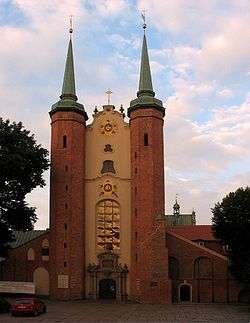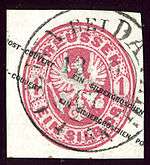Oliwa
Oliwa, also Oliva (Kashubian: Òlëwa), is one of the quarters of Gdańsk, Poland. From east it borders Przymorze and Żabianka, from the north Sopot and from the south with the districts of Strzyża, VII Dwór and Brętowo, while from the west with Matarnia and Osowa. It is known for its medieval monastery, the 1627 Battle of Oliva and the 1660 Peace of Oliva.
 Opatów Palace in Oliwa |
 Oliva Cathedral |
Administration
Oliwa is a part of the northern Polish city of Gdańsk. It is bordered on the east by the Bay of Gdańsk (Zatoka Gdańska), on the north by the town of Sopot, on the south by the boroughs of Wrzeszcz and Zaspa and on the west by the chain of hills and forest surrounding Gdańsk. Except for the 'old city' Oliwa encompasses the boroughs of Polanki, Jelitkowo, Przymorze and Zabianka.
Population and sites
The population in 2004 was 19,824. The area is 18.23 km² with a population density of 1,087 persons per square km. An interesting site is the old cathedral. Other sites to see are the kloster palace with a park and a botanical garden.
History
Oliva abbey
It is not exactly known when Oliwa was established. Archeological excavations suggest that the first settlement in this area was established in early Iron Age. The Cistercian Monks' tradition (unconfirmed by other sources) speaks of it as an early seat of power of the Pomeranian Princes. The name of this suspected burgh is unknown.
The first mention of Oliwa dates to AD 1186 when the Cistercians established a monastery there. The Cistercian Monks named it Oliva, either derived from an older Slavic name or the biblical Mount of Olives or olive tree. The monks received a deed of ownership from the contemporary Pomeranian duchies and dukes Sambor I of Pomerania in 1188. The deed encompassed a number of villages, including Oliwa which became a monastic village for long centuries to come. The village's history is directly linked to the development of the monastery.
Famous events in the history of Oliwa were the 1627 Battle of Oliva during the Swedish invasions and the 1660 Peace of Oliva.
As a result of the 1st Partition of Poland in 1772 Oliwa became part of Prussia, at that time it was inhabited by about 500 people and counting approximately 70 buildings. The Prussians confiscated all of the Cistercian Monks' possessions. The abbey prior received a salary and the monastery received financial reparations. In 1804 Oliva became an administrative headquarters for the surrounding villages and the administrator settled in the former abbey gatehouse.
Oliva as a Danzig (Gdansk) suburb
In 1807 the Napoleonic armies took the village over and set up a field hospital in the abbey. Napoleon stayed in one of the local estates. Oliva became part of the Free City of Danzig until 1813 when the Russians entered Oliva and once again used the abbey as a field hospital. In 1815 Oliva and Danzig became part of the Prussian Kingdom.
A period of relative calm ensued. In 1822 a paved road joining Oliva and Danzig was built. In 1831 the monastery was liquidated. The abbey became a Catholic parish and the former parish church was transferred to the local Evangelical Protestant community. The Oliva parish consisted of a number of small settlements from Zoppot (Sopot) to Danzig including today's boroughs of Wrzeszcz, Zaspa, Nowy Port, Wysoka and Rynarzewo. The Dom Bramny underwent renovation in 1836 so as to be able to function as a modern administrative center. Gustav Schilling was nominated as the first Vogt (administrator of a number of villages) in 1852.

In 1864 the villages of Polanki and Schwabenthal became part of Oliva, which by then numbered approximately 2000 inhabitants. In 1867 a new Vogt is nominated i.e. Herman Tümmler. During his term Oliva gained a rail connection with Danzig (Gdańsk) and Köslin (Koszalin) in 1870. In 1873 a local enterprise Quistrop established a horse drawn tramline. The line met its demise in 1879 because it was not very profitable. In 1874 Oliva becomes a township and the first community leader is Georg Czachowski. During his term a number of paved roads joining the township with surrounding settlements were built and the number of inhabitants surpassed 4000. Between 1885 and 1907 Oliva was headed by a number of administrators and slowly expanded in all directions, not in the least due to the continuing efforts in improving the infrastructure. The seaside community of Jelitkowo was incorporated by Oliva in 1907. Jelitkowo became a center of leisure with bathhouses and a wooden pier. In the same year a gas factory was built. In 1911 Oliva received running water, although a sewage system was not installed until 1921. By 1910 there were more than 9000 inhabitants.
In 1910 Oliva celebrated the 250th anniversary of the Treaty of Oliva. In 1911 a Catholic school was established at today's Cistercians' Street. The surrounding forest was enriched by a Hortus Botanicus in 1912. In 1913 another railway line was added, joining Oliva with the Kashubian town of Kościerzyna. After World War I and on the basis of the Treaty of Versailles the Free City of Danzig was established on November 15, 1920 under the protectorate of the League of Nations and Poland. The borders of the free city included Oliva; a part of the parish was however in Poland.
In 1921 Herbert Creutzburg was nominated as the mayor of Oliva. His term was disastrous. He wanted to open a casino styled on the Sopot casino (by then Sopot was a renowned seaside spa). He ruined the city funds and the losses amounted to 400.000 guilders. The losses were paid up by the city of Danzig which sped up the incorporation of Oliva by Danzig on July 1, 1926. The remainder of the twenties brought a lot of prosperity. A paint factory "Daol" and a chocolate factory "Anglas" were established. These still exist today, although under different names. The world-renowned Dr.Oetker company also established a factory in Oliva in the twenties. In 1926 a small Zoo and fur farm were established. The Zoo is today one of the largest in Poland. The most important event of 1926 were however the celebrations of the 750th anniversary of Oliwa
In the thirties the National-Socialist NSDAP was gaining strength in the free city. In 1930 the party numbered 500 in Danzig. In 1932 when Adolf Hitler made a stopover at the Zaspa airport he was greeted by 10,000 NSDAP members. In 1939 the square in front of the (then recently upgraded) Oliva cathedral was paved with granite slabs and was frequently used as a drill terrain for the Hitlerjugend. On August 23, 1939 Albert Forster was named head of state and took full control of the free city. A week later World War II started when the German cruiser Schleswig-Holstein attacked a small outpost on the Westerplatte. Polish activists including priests were arrested by the Germans who took over all the important control points and marched into Poland. Freie Stadt Danzig with Oliva, together with the Polish Pomeranian Voivodeship (Polish Corridor) were annexed by the Reich as Reichsgau Danzig-Westpreussen.
In March 1945 the advancing Red Army captured Oliva (and the surrounding regions). The land was handed over to Poland. During the post war years Oliwa developed in tune with the rest of the city of Gdańsk.
Timeline
- 1224 (1226?) i 1234 (1236?) – incursions of Prussians
- 1246, 1247, 1252 – incursions of Teutonic Knights
- 1295 – Pomerelia claimed to be inherited by both Margraviate of Brandenburg and Poland
- 1308 – incursion of Brandenburg army. The monastery and Pomerelia is annexed by Teutonic Order in 1309 after the Teutonic takeover of Danzig (Gdansk)
- 1350 – The monastery is destroyed by fire.
- 1433 – Incursions of Hussites during Polish-Teutonic Order war
- 1454 – Thirteen Years' War and the annexation of Pomerelia by Poland
- 1466 – Second Peace of Thorn (1466): the monastery and Pomerania go to Poland, but then receive exempt status.
- 1577 – defending against Polish King's attempted conquest in the Siege of Danzig, Danzig (Gdańsk) army destroyed the monastery
- 1588, 1653, 1709 – various epidemics
- 1626 – Protestant invasion by Gustavus Adolphus of Sweden during the Thirty Years' War
- 1627 – a sea battle near Oliwa (Schlacht bei Oliva)
- 1656 – Swedish invasion
- 1660 – Oliva peace treaty in 1660 between the Emperor Leopold I, Elector of Brandenburg, Poland and Sweden.
- 1733-1734 – devastation during the war of Polish succession
- 1772 – First Partition of Poland: the property of monastery is expropriated by Prussian King
- 1807 – Oliva taken over by Napoleon's army, Kloster turned into hospital. Oliva is included into Free City of Danzig.
- 1813 – Russian army takes over Oliva
- 1813 – Oliva is again annexed by Prussian kingdom
- 1831 – Oliva Abbey is closed. The church of the monastery becomes a Catholic church, the second church is given to Protestants.
- 1864 – Oliva is extended to include (Polanki and Dolina Radosci) Schwabenthal.
- 1874 – Oliva is elevated to the rank of a city.
- 1907 – Jelitkowo (Glettkau) and Zabianka (Poggenkrug), Przymorze Konradshammer included into city.
- 1920 – Oliva is separated city inside Freie Stadt Danzig
- 1922 – Danzig bishop Edward O'Rourke comes to the newly created bishopry (eventually in 1925).
- 1921 – Herbert Creutzburg becomes mayor of Oliva. The city goes down into bankruptcy and eventually becomes one of the quarters of Danzig (Gdańsk).
- 1926 – Oliva cease to be an independent city
- 1927 – The monastery palace is turned into a Museum ("Staatliches Landesmuseum für Danziger Geschichte"). The first manager is Erich Keyser.
- September 1 1939 – The beginning of World War II. Oliva is annexed by Germany to the province Danzig-West Prussia.
- March 25 1945 – Advancing Red Army captures Oliva. The land is given to Poland as Oliwa and Gdańsk.
See also
External links
Coordinates: 54°24′38″N 18°33′32″E / 54.41056°N 18.55889°E